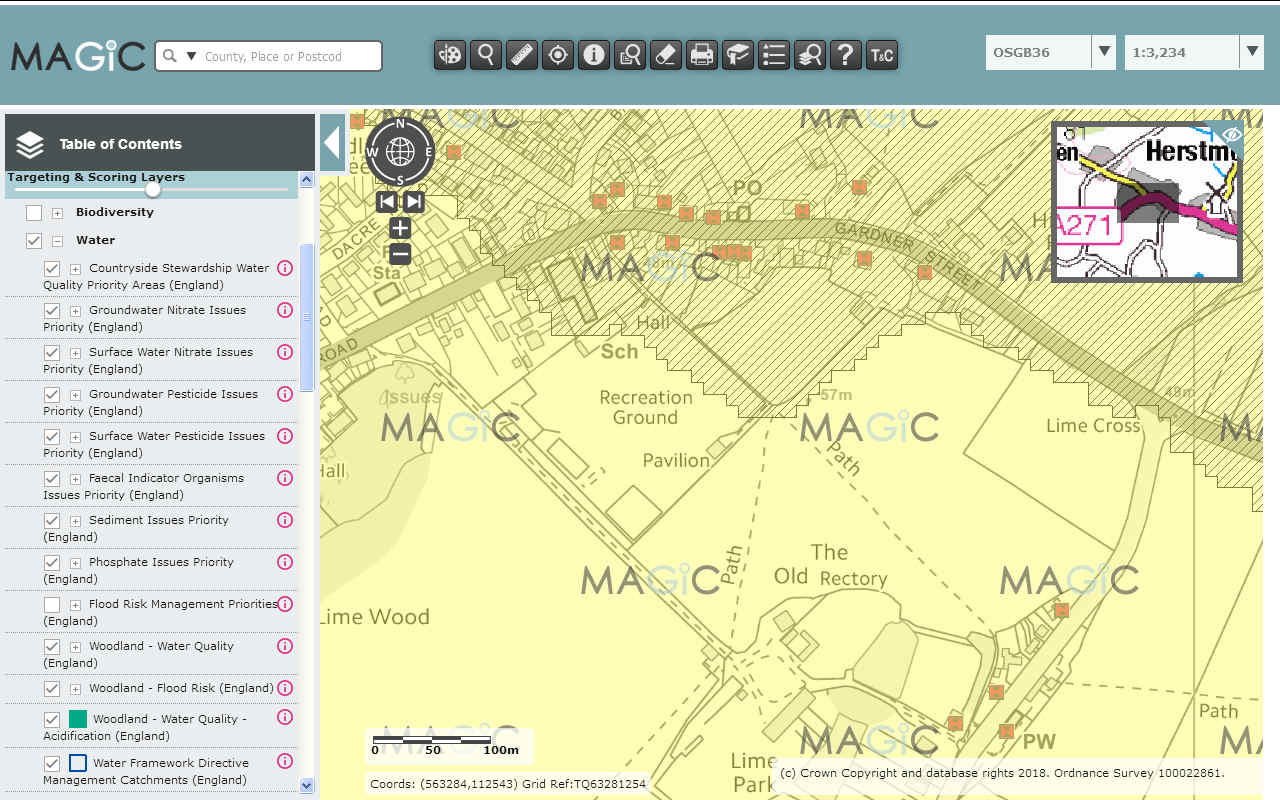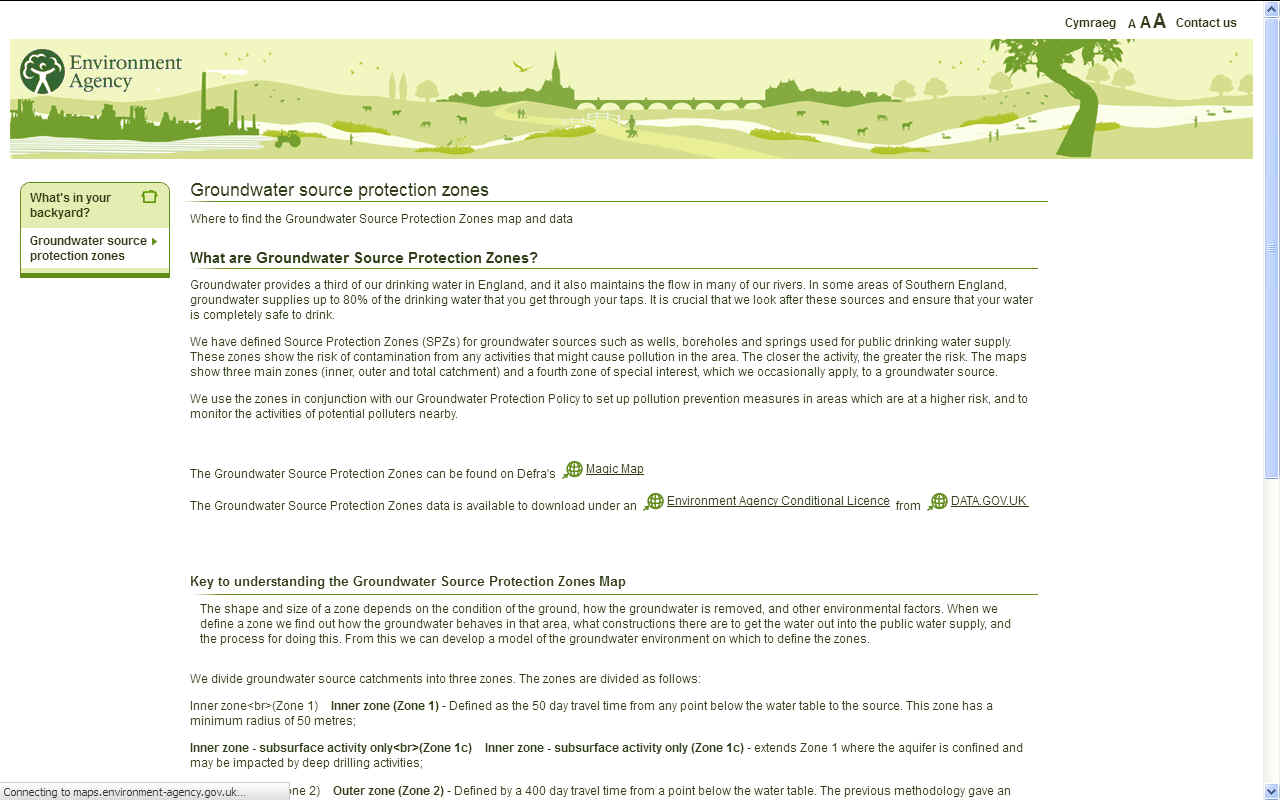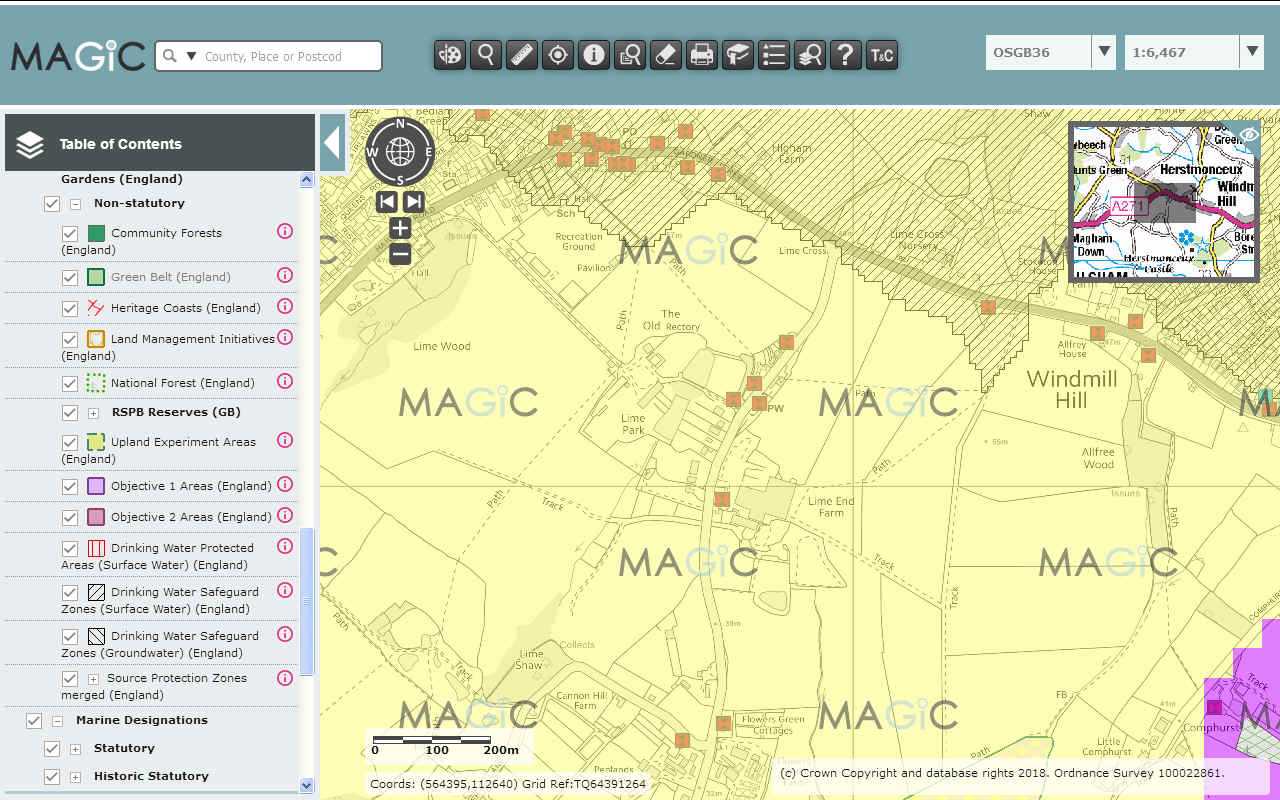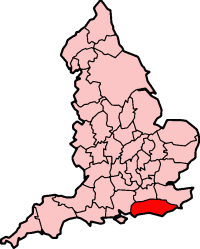|
ENVIRONMENT AGENCY
|
|
|
GROUNDWATER
SOURCE PROTECTION ZONES
The EA have defined Source Protection Zones (SPZs) for groundwater sources such as wells, boreholes and springs used for public drinking water supply. These zones show the risk of contamination from any activities that might cause pollution in the area. The closer the activity, the greater the risk. The maps show three main zones (inner, outer and total catchment) and a fourth zone of special interest, which we occasionally apply, to a groundwater source.
The EA use the zones in conjunction with our Groundwater Protection Policy to set up pollution prevention measures in areas which are at a higher risk, and to monitor the activities of potential polluters nearby.
WATER CONTAMINATION - If houses are built on the hill that supplies the last surviving well in Herstmonceux, all of those who presently enjoy a sustainable water supply are likely to be poisoned by pesticides from the gardens of the proposed housing. In addition, where the hard standings of a proposal for 70 houses are to be gully drained to a point lower than the twin wells, soakage that supplies the wells will be diverted away potentially starving the wells of water and increasing pesticide accumulations from the proposed garden areas. The amusing cartoon above portrays the situation that perhaps the developers were not aware of, when they bought into a situation that they should have been able to rely on - if there had been a competent appraisal by Wealden District Council, the County Archaeologist and the Environment Agency. Unfortunately, the council concerned and the advisers to the original applicants appear to have been less diligent than they might have been in the rush to profit from a windfall situation. The developers in this case are confirmed to be: Clarion Housing Group, Thakeham Homes and Latimer Developments. Previously, the site was owned by Tim Watson and then Gleeson Developments. We understand that Mrs Claire Turner and Christopher Bending are two of the planning officers now with responsibility for this application which has reached the detailed (reserved matters) stage.
UNDERSTANDING
THE GROUNDWATER SOURCE PROTECTION ZONES MAP
DISCHARGES TO SURFACE WATER & GROUNDWATER: ENVIRONMENTAL PERMITS
When you need an environmental permit to discharge liquid effluent or waste water to surface water or onto the ground, and how to apply. You may need an environmental permit if you discharge liquid effluent or waste water (poisonous, noxious or polluting matter, waste matter, or trade or sewage effluent):
You need to apply to the Environment Agency for a permit for any standalone water discharge or groundwater activity - standalone means the activity is not part of a waste operation, installation or mining waste operation.
If your water discharge is part of one of these operations, you can make the discharge part of your installation permit or waste or mining waste permit.
You’re breaking the law if you operate without a permit if you should have one.
When you do not need a permit
You do not need a permit:
For more information about the Environment Agency’s position on protecting groundwater, see Groundwater protection position statements. Position statement G12 on page 29 explains when you do not need a permit for discharge of clean roof water to ground. Discharges in sewered areasYou should discharge your waste water to the public foul sewer whenever it’s reasonable to do so. You do not need an environmental permit to do this. You must consult your sewerage undertaker before you:
Permits in sewered areas
The Environment Agency will not give you a permit for a private sewage treatment system if it’s reasonable for you to connect to the public sewer. If the distance from the boundary of your site to the nearest public sewer is less than the number of houses multiplied by 30 metres, you must show the Environment Agency why it’s not reasonable to connect to the public sewer. In some cases, we may ask you to consider connecting to the public sewer if it’s more than the number of houses multiplied by 30 metres away. Contact the Environment Agency to discuss your proposal before you apply for a permit. You will need to:
When we assess whether it’s reasonable for you to connect to the public sewer we take into account:
If you’re planning a new development, plan your foul sewerage at an early stage and consult with the local authority and sewerage undertaker.
We will not normally give you a permit if you want to use a private sewage treatment system because there’s not enough capacity in the nearest public sewer. If necessary, you must agree improvements to the existing sewerage network, in order to allow connection, with the sewerage undertaker. These improvements must be put in place before the development is occupied. This aligns with planning practice guidance and the building regulations.
Disputes over connection to the public sewer
Your sewerage undertaker may have a duty to provide a first time sewerage scheme if:
Check the guidance for your activity
Your water discharge or groundwater activity may meet the conditions for an exemption from environmental permitting or a standard rules permit. For more information read the relevant guidance for:
You’ll need to apply for a bespoke permit if none of the above apply to you.
Contact the Environment Agency if you’re not sure if you need a permit.
Type of waste water: domestic sewage or trade effluent
As part of your permit application, or to know whether your activity qualifies for an exemption, you will need to classify your waste water. Read more about when your waste water is classed as domestic sewage.
Standard rules permits for package treatment plants
You may be able to apply for a standard rules permit if you operate a package treatment plant for secondary treatment of domestic sewage.
Your package treatment plant must discharge between 5 and 20 cubic metres of domestic treated sewage to surface water daily (for example, your plant treats sewage from a small hotel or bed and breakfast, not a single household). If your sewage discharge to surface water is less than 5 cubic metres per day and you meet the general binding rules, you do not need a permit.
Your operation must meet the description and rules, but:
Applying for a standard rules permit is usually quicker than a bespoke permit. If you do not meet the conditions for the standard rules permits you must apply for a bespoke permit.
Apply for a standard rules permit
Before you apply for a standard rules permit you need to:
Standard rules permits: application forms
Download and fill in these forms: Send your completed forms and application fee to PSC-WaterQuality@environment-agency.gov.uk or post them to:
Environment
Agency Permitting and Support Centre Find out about:
Before you apply for a bespoke permit
You need to:
If you’re a water company or NAV (new appointments and variations) you must follow the guidance relevant to your activity:
Specific substances assessment
When you apply for a permit you’ll need to tell the Environment Agency if your discharge will contain specific substances.
If your discharge contains specific substances your risk assessment will need to include a specific substances assessment.
Find the list of surface water specific substances in the surface water pollution risk assessment guide.
For discharges to groundwater, a specific substances assessment is needed for hazardous substances and non-hazardous pollutants. This does not include discharges that only contain or are only likely to contain ammoniacal nitrogen, ammonium and suspended solids. Find the list of hazardous substances and non-hazardous pollutants for groundwater on the Water Framework Directive UK TAG website.
Apply for a bespoke permit
Standalone water discharge and groundwater activity permit (not open-loop heat pump systems)
Download and fill in forms: Open-loop heat pump systems
Download and fill in forms: Standalone groundwater discharges with spreading activities permit
Download and fill in forms:
Send your application
When you send your application you’ll need to include:
Email your completed forms to PSC-WaterQuality@environment-agency.gov.uk or you can post them to:
Environment
Agency Permitting and Support Centre
Get help with your application
The Environment Agency offers basic pre-application advice to help you complete your application. This basic advice is free as the cost of providing it is included in the application charge. For standard rules and bespoke permits the basic service covers the following advice (where applicable):
For bespoke permits, the basic service also includes advice about risk assessments you may need to do to accompany your application.
If you need more in depth advice about your application the Environment Agency offers an enhanced pre-application advice service. The enhanced service costs £100 an hour plus VAT. It can include face to face meetings and advice on:
The Environment Agency will give you a written estimate before it starts work. This will include:
Getting pre-application advice will help you submit a good quality application that can be processed (determined) smoothly and quickly. Complete the pre-application advice form if you want to request either basic (free), or enhanced (chargeable), pre-application advice.
If you cannot access the form please contact the Environment Agency. It will send you a paper copy to complete and return.
Check that you meet the ‘legal operator’ requirements
You must be the ‘legal operator’ of the water discharge or groundwater activity that you want a permit for.
This means you must have sufficient control of the activity, for example you:
You can have contractors carry out activities at your site and remain the operator if you continue to have sufficient control of the activity. But sometimes a contractor may be the legal operator or become the legal operator, based on the tests set out above. A remote holding company is unlikely to have sufficient control.
If you’re no longer the operator you must formally transfer the permit to the person who is the operator. If you continue to operate an activity when you’re no longer the legal operator the Environment Agency may take enforcement action against you or revoke the permit. You must apply as a ‘legal entity’ that can be legally responsible for the permit and can accept liability, for example:
As the operator you’re legally responsible for the activity whether or not it’s in operation. Your application can be refused if the Environment Agency does not consider you to be the operator or a legal entity.
Joint operators of one activity
If your activity has more than one operator acting together, you need to make one joint application for all the operators. For example if several people jointly operate a treatment plant then they would all be named on the permit.
Keep sensitive information confidential
When the Environment Agency consults on your permit application it will let people see the information in your application.
You can ask the Environment Agency not to make public any information that is commercially sensitive for your business (for example, financial information). You can do this by including a letter with your application that gives your reasons why you do not want this information made public. The Environment Agency will email or write to you within 20 days if it agrees to your request. It will let you know if it needs more time to decide.
If it does not agree to your request it will tell you how to:
Fees and charges
You must pay a fee to apply for a permit.
You must send your fee with your application. If your application’s successful, the Environment Agency normally charge you an annual ‘subsistence’ fee while you have a permit. This fee depends on your activity and the type of permit you have.
Find out more about fees and charges. You can contact the Environment Agency for help to work out your fee.
After you apply
The Environment Agency may reject your application if, for example:
Once the Environment Agency has the information it needs to start assessing your application, it will contact you and tell you that your application is ‘duly made’. This means it’s starting the assessment process. It may still request more information if it needs it to complete its assessment.
Consultations on your permit application
The Environment Agency will publish online a notice of your application and instructions for how other people can see and comment on it.
Members of the public and anyone interested in the application have 20 working days to comment. The Environment Agency may also consult other public bodies, for example, local authorities, Public Health England, water companies and Natural England.
If the Environment Agency considers your application to be of high public interest, it may:
The Environment Agency’s public participation statement explains how and why it will consult on permit applications.
Decisions about your permit
The Environment Agency will write to you to tell you its decision about whether or not it can allow what you’ve asked for.
You should normally get a decision on your application within 13 weeks. The Environment Agency will tell you if your application will take longer.
You can appeal if it refuses your application or if you’re not happy with the conditions it has put into your permit. Its decision letter will explain how you can appeal.
The Environment Agency will publish the decision on its public register.
The Environment Agency will not normally change your permit within 4 years of it being issued. However, it may change your permit if:
Comply with your permit
After you’ve been granted your permit you’ll need to comply with its conditions. Find out how the Environment Agency will regulate you when you start operating.
Change, transfer or cancel your permit
After you have your permit, you can:
Find out how to change, transfer or cancel your permit.
MAJOR
OUTLINE APPLICATION HERSTMONCEUX WD/2015/0090/MAO - CONDITIONS
1.2. In accordance with that condition:
CONTACT
ENVIRONMENT AGENCY National Customer Contact Centre
Tel: 03708 506 506
Email: enquiries@environment-agency.gov.uk
SUSSEX INDEX A - Z
CHIDDINGLY - HORSE SHOW and GYMKHANA CUCKMERE VALLEY - EXCEAT HERSTMONCEUX - MUSEUM - COSTS SCANDAL - PARISH COUNCIL - 70 HOUSES - RAF TWISSELLS MILL, OLD HEATHFIELD
http://apps.environment-agency.gov.uk/wiyby/37833.aspx http://magic.defra.gov.uk/MagicMap.aspx https://www.southernwater.co.uk/
|



